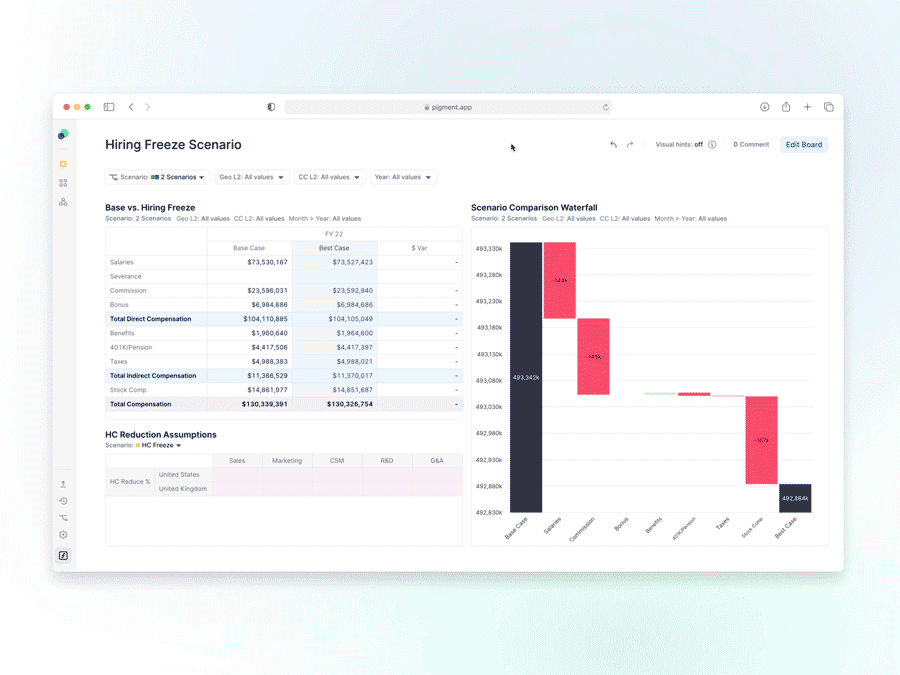Rarely does everything go to plan - it’s for that reason that Eisenhower once said ‘a plan is useless, but planning is everything.’
This is the central idea behind scenario planning.
Effective scenario planning is indispensable in a volatile business environment. It’s one of the most high-impact deliverables for any FP&A team.
By planning for a range of outcomes, organizations can increase their general readiness: becoming resilient to negative impacts and more able to capitalize on opportunities.
Let’s explore how best-in-class FP&A teams do it.
When should I conduct scenario planning?
The best time to do scenario planning is literally all the time.
Best-in-class teams have integrated scenario planning into their ongoing planning processes, giving them a view into the potential future states of their organization, rather than just one forecast.
A typical spread of business-as-usual scenarios might look like this:
Base case
This is the most realistic or expected outcome based on current assumptions, historical trends, and available data. It serves as the reference point against which other scenarios are compared.
Best case
This reflects the most optimistic outcome where everything goes better than expected. It helps you understand the upside potential if favorable conditions align.
Worst case
This is the pessimistic outlook, assuming setbacks, risks materializing, or external shocks. It helps you stress test resilience and identify risk mitigation strategies.
Momentum case
Unlike the base case (which may include judgment calls), the momentum case assumes current trends continue without major changes.
McKinsey makes the argument for a momentum case here - essentially, they offer a completely unbiased look into the future.
But scenario planning can also be conducted ad-hoc in response to business conditions - big macroeconomic shifts, market disruptions, or evaluating the risk of losing key contracts.
The exact ‘mix’ of scenarios you prepare for will depend on the specifics of your organization. But each scenario is made up of a series of assumptions.
Determining your assumptions
A technique that can be helpful when scenario planning is sensitivity analysis. This involves testing how ‘sensitive’ a metric is to changes in particular variables.
If had a simple model that predicts next year’s revenue based on:
- Price per unit
- Units sold
- Discount rate
You could perform a sensitivity analysis to see how net profit changes when each input increases or decreases by 5%, 10%, etc.
The results help you prioritize which drivers most affect performance, which can in turn inform the assumptions you use to build your scenarios.
The foundation of both sensitivity analysis and scenario planning is driver-based planning: which focuses on building models around variables that most directly influence outcomes.
Best practice when building your scenarios
As we mentioned before, the range of scenarios that your business should maintain will depend entirely on the specifics of your organization. But there are a few rules of thumb you should keep in mind that are always helpful.
Keep them distinct
The idea of scenario planning is to prepare for a broad range of outcomes. If your scenarios are too similar you’re going against the spirit of the exercise, and wasting time. Keep them materially different.
Keep them realistic
Similarly, if you’re preparing for extremely unlikely circumstances, you’re also likely wasting time.
Limit the number
Scenarios do take time to build and maintain. Aim for a realistic maximum to ensure you’re not wasting resources.
Document assumptions and write a narrative
Ensure that your assumptions, which could be internal (like headcount growth, pricing strategy, or productivity) or external (like inflation rates, demand shifts, regulatory changes) are documented somewhere.
For each assumption, record:
- Who is ultimately responsible
- Where it came from (data/expert opinion/best guess etc)
- When it was last updated
Each scenario should have a short accompanying ‘narrative’ that you can use to simply explain it to an executive.
Create scenario playbooks
Each scenario should include rules that determine what actions should be taken in the event of that scenario playing out, with clear ‘triggers’. For example:
“If revenue falls below $5M for two quarters, we’ll freeze new hiring.”
Maintaining these playbooks will ensure that when the time does come to act, everyone at your organization knows exactly what to do - essentially, it lowers your reaction time.
How it works in Pigment
To see how scenario planning works in Pigment, click here to view the knowledge base article.

Alternatively, you can book a demo or join our next live tour to see it in action yourself.
.jpeg)



